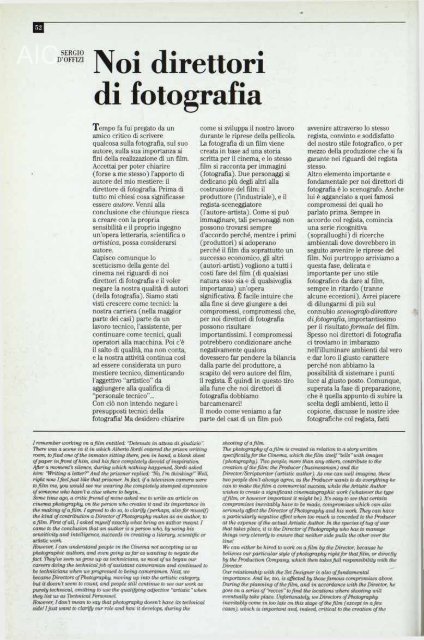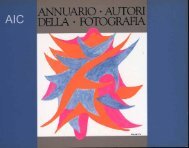ITALIANA - AIC Associazione Italiana Autori della Fotografia ...
ITALIANA - AIC Associazione Italiana Autori della Fotografia ...
ITALIANA - AIC Associazione Italiana Autori della Fotografia ...
Create successful ePaper yourself
Turn your PDF publications into a flip-book with our unique Google optimized e-Paper software.
<strong>AIC</strong><br />
SERGIO<br />
Noi D'OFFIZI<br />
direttori<br />
di fotografia<br />
Tempo fa fui pregato da un<br />
amico critico di scrivere<br />
qualcosa sulla fotografia, sul suo<br />
autore, sulla sua importanza ai<br />
fini <strong>della</strong> realizzazione di un film.<br />
Accettai per poter chiarire<br />
(forse a me stesso) l'apporto di<br />
autore del mio mestiere: il<br />
direttore di fotografia. Prima di<br />
tutto mi chiesi cosa significasse<br />
essere autore. Venni alla<br />
conclusione che chiunque riesca<br />
a creare con la propria<br />
sensibilità e il proprio ingegno<br />
un'opera letteraria, scientifica o<br />
artistica, possa considerarsi<br />
autore.<br />
Capisco comunque lo<br />
scetticismo <strong>della</strong> gente del<br />
cinema nei riguardi di noi<br />
direttori di fotografia e il voler<br />
negare la nostra qualità di autori<br />
(<strong>della</strong> fotografia). Siamo stati<br />
visti crescere come tecnici: la<br />
nostra carriera (nella maggior<br />
parte dei casi) parte da un<br />
lavoro tecnico, l'assistente, per<br />
continuare come tecnici, quali<br />
operatori alla macchina. Poi c'è<br />
il salto di qualità, ma non conta,<br />
e la nostra attività continua così<br />
ad essere considerata un puro<br />
mestiere tecnico, dimenticando<br />
l'aggettivo "artistico" da<br />
aggiungere alla qualifica di<br />
"personale tecnico"...<br />
Con ciò non intendo negare i<br />
presupposti tecnici <strong>della</strong><br />
fotografia! Ma desidero chiarire<br />
I remember working on a film entitled: "Detenuto in attesa di giudizio".<br />
There was a scene in it in which Alberto Sordi entered the prison writing<br />
room, to find one of the inmates sitting there, pen in hand, a blank sheet<br />
of paper in front of him, and his face completely devoid of inspiration<br />
After a moment's silence, during which nothing happened, Sordi asked<br />
him: "Writing a letter?" And the prisoner replied: "No, I'm thinking!" Well,<br />
right now I feel just like that prisoner. In fact, if a television camera were<br />
to film me, you would see me wearing the completely stumped expression<br />
of someone who hasn't a clue where to begin..<br />
Some time ago, a critic friend of mine asked me to u/rite an article on<br />
cinema photography, on the person who creates it and its importance in<br />
the making of a film. I agreed to do so, to clarify (perhaps, also for muself)<br />
the kind of contribution a Director of Photography makes as an author, to<br />
a film. First of all, I asked myself exactly what being an author meant. I<br />
came to the conclusion that an author is a person who, by using his<br />
sensitivity and intelligence, succeeds in creating a literary, scientific or<br />
artistic work.<br />
However, I can understand people in the Cinema not accepting us as<br />
photographic authors, and even going asfar as wanting to negate the<br />
fact They've seen us grow up as technicians, as most of us began our<br />
careers doing the technical job of assistant cameraman and continued to<br />
be technicians when we progressed to being cameramen. Next, we<br />
became Directors of Photography, moving up into the artistic category,<br />
but it doesn't seem to count, and people still continue to see our work as<br />
purely technical, omitting to use the qualifying adjective "artistic" when<br />
they list us as Technical Personnel.<br />
However, I don t mean to say that photography doesn't have its technical<br />
side! I just want to clarify our role and how it develops, during the<br />
come si sviluppa il nostro lavoro<br />
durante le riprese <strong>della</strong> pellicola.<br />
La fotografia di un film viene<br />
creata in base ad una storia<br />
scritta per il cinema, e lo stesso<br />
.film si racconta per immagini<br />
(fotografia). Due personaggi si<br />
dedicano più degli altri alla<br />
costruzione del film: il<br />
produttore (l'industriale), e il<br />
regista-sceneggiatore<br />
(l'autore-artista). Come si può<br />
immaginare, tali personaggi non<br />
possono trovarsi sempre<br />
d'accordo perché, mentre i primi<br />
(produttori) si adoperano<br />
perché il film dia soprattutto un<br />
successo economico, gli altri<br />
(autori-artisti) vogliono a tutti i<br />
costi fare del film (di qualsiasi<br />
natura esso sia e di qualsivoglia<br />
importanza) un'opera<br />
significativa. È facile intuire che<br />
alla fine si deve giungere a dei<br />
compromessi, compromessi che,<br />
per noi direttori di fotografia<br />
possono risultare<br />
importantissimi. I compromessi<br />
potrebbero condizionare anche<br />
negativamente qualora<br />
dovessero far pendere la bilancia<br />
dalla parte del produttore, a<br />
scapito del vero autore del film,<br />
il regista. E quindi in questo tiro<br />
alla fune che noi direttori di<br />
fotografia dobbiamo<br />
barcamenarci!<br />
Il modo come veniamo a far<br />
parte del cast di un film può<br />
avvenire attraverso lo stesso<br />
regista, convinto e soddisfatto<br />
del nostro stile fotografico, o per<br />
mezzo <strong>della</strong> produzione che si fa<br />
garante nei riguardi del regista<br />
stesso.<br />
Altro elemento importante e<br />
fondamentale per noi direttori di<br />
fotografia è lo scenografo. Anche<br />
lui è agganciato a quei famosi<br />
compromessi dei quali ho<br />
parlato prima. Sempre in<br />
accordo col regista, comincia<br />
una serie ricognitiva<br />
(sopralluoghi) di ricerche<br />
ambientali dove dovrebbero in<br />
seguito avvenire le riprese del<br />
film. Noi purtroppo arriviamo a<br />
questa fase, delicata e<br />
importante per uno stile<br />
fotografico da dare al film,<br />
sempre in ritardo (tranne<br />
alcune eccezioni). Avrei piacere<br />
di dilungarmi di più sul<br />
connubio scenografo-direttore<br />
di fotografia, importantissimo<br />
per il risultato formale del film.<br />
Spesso noi direttori di fotografia<br />
ci troviamo in imbarazzo<br />
nell'illuminare ambienti dal vero<br />
e dar loro il giusto carattere<br />
perché non abbiamo la<br />
possibilità di sistemare i punti<br />
luce al giusto posto. Comunque,<br />
superata la fase di preparazione,<br />
che è quella appunto di subire la<br />
scelta degli ambienti, letto il<br />
copione, discusse le nostre idee<br />
fotografiche col regista, fatti<br />
shooting of a film.<br />
The photography of a film is created in relation to a story written<br />
specifically for the Cinema, which the film itself "tells" with images<br />
(photography). Two people, more than any others, contribute to the<br />
creation of the film: the Producer (businessman) and the<br />
Director/Scriptwriter (artistic author). As one can well imagine, these<br />
two people don't always agree, as the Producer wants to do everything he<br />
can to moke the film a commercial success, while the Artistic Author<br />
wishes to create a significant cinematographic work (whatever the type<br />
of film, or however important it might be). It's easy to see that certain<br />
compromises inevitably have to be made, compromises which can also<br />
seriously affect the Director of Photography and his work. They can have<br />
a particularly negative effect when too much is conceded to the Producer<br />
at the expense of the actual Artistic Author. In the species of tug of war<br />
that takes place, it is the Director of Photography who has to manage<br />
things very cleverly to ensure that neither side pulls the other over the<br />
line!<br />
We can either be hired to work on a film by the Director, because he<br />
believes our particular style of photography right for that film, or directly<br />
by the Production Company, which then takes full responsibility with the<br />
Director.<br />
Our relationship with the Set Designer is also of fundamental<br />
importance. And he, too, is affected by those famous compromises above.<br />
During the planning of the film, and in accordance with the Director, he<br />
goes on a series of 'Recces " to find the locations where shooting mil<br />
eventually take place. Unfortunately, we Directors of Photography<br />
inevitably come in too late on this stage of the film (except in a few<br />
cases), which is important and, indeed, critical to the creation of the









